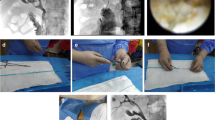Abstract
Forty-one patients underwent nonsurgical removal of postoperatively retained bile duct stones in two nonrandomized groups. The endoscopic-retrograde technique was used in 21 patients, and succeeded in 19. The percutaneous approach through the T-tube tract was used in 22 patients, including the two in whom endoscopic stone removal had failed, and was successful in 21 patients. Individual preferences and prior history introduced a selection bias against the percutaneous technique. Auxiliary extracorporeal shockwave lithotripsy (ESWL) was used in 2 patients whose stones could not be fragmented mechanically by the percutaneous basket technique. ESWL was successful in one patient but failed in the second. Because endoscopy had also failed in this case, the patient subsequently underwent repeat surgery. Procedure-related complications were minor with both techniques and were readily treated by conservative measures. We conclude that both the retrograde and the percutaneous approaches are effective and safe. The endoscopic approach appears convenient because there is no need to await maturation of the percutaneous tract, but sphincterotomy carries a small but distinctive risk. Because the percutaneous approach uses an existing tract, is only minimally invasive and leaves the sphincter of Oddi intact, it is preferable in those patients who have T-tubes of approapriate size and position in place.
Similar content being viewed by others
References
Burhenne HJ (1973) Nonoperative retained biliary tract stone extraction. A new roentgenologic technique. AJR 117:388–399
Burhenne HJ (1976) Complications of nonoperative extraction of retained common duct stones. Am J Surg 131: 260–262
Burhenne HJ (1980) Percutaneous extraction of retained biliary tract stones: 661 patients. AJR 134:888–898.
Caprini JA, Thorpe CJ, Fotopoulos JP (1980) Results of nonsurgical treatment of retained biliary calculi. Surg Gynecol Obstet 151:630–634
Mazzariello RM (1978) A 14-year experience with nonoperative instrument extraction of retained bile duct stones World J Surg 2: 447–455
Caprini JA (1988) Biliary stone extraction. Am Surg 54:343–347
Taylor BR, Ho CS (1984) Nonsurgical treatment of common-bile-duct stones. Can J Surg 27:28–32
Geisinger M, Owens DB, Meaney JF (1989) Radiologic methods of bile duct stone extraction. Am J Surg 158:222–227
Mason R (1980) Percutaneous extraction of retained gallstones via the T-tube tract: British experience of 131 cases. Clin Radiol 31:497–499
Nussinson E., Cairns SR, Vaira D, Dowsett JF Mason RR (1991) A 10 year single-centre experience of percutaneous and endoscopic extraction of bile duct stones with T-tube in situ Gut 32: 1040–1043
Dähnert W. Günther R, Schmidt HD, Staritz M, Thelen M (1984) Entfernen zurückgelassener Gallengangskonkremente durch den T-Drainkanal. Fortschr Röntgenstr 141:63–68
Schnyder PA (1980) Extraction postopératoire de calculs résiduels des voies biliaires. Schweiz Med Wschr 110:154–159
Bickerstaff KI, Berry AR, Chapman RW, Britton J (1988) Early postoperative sphincterotomy for retained biliary stones. Ann R Coll Surg Engl 70:350–351
Simpson CJ, Gray GR, Gillespie G (1985) Early endoscopic sphincterotomy for retained common bile duct stones JR Col Surg Edinb 30:288–289
O'Doherty DP, Neoptolemos JP, Carr-Locke DL (1986) Endoscopic sphincterotomy for retained common bile duct stones in patients with T-tube in situ in the early post operative period. Br J Surg 73:454–456
Lambert ME, Martin DF, Tweedle DEF (1988) Endoscopic removal of retained stones after biliary surgery Br J Surg 75:896–898
Cotton PB (1984) Endoscopic management of bile duct stones (apples and oranges). Gut 25:587–597.
Sherman S., Ruffolo TA, Hawes RH, Lehman GA (1991) Complications of endoscopic sphincterotomy. Gastroenterology 101:1068–1075.
Vaira D D'Anna L, Ainley C, Williams S, Cairns S., Salmon P, Russell C, D'Anna L, Dowsett J, Baillie J, Croker J Cotton P, Hatfield A (1989) Endoscopic sphincterotomy in 1000 consecutive patients. Lancet 2:431–434
Winstanley PA, Ellis WR, Hamilton I, Lintott DJ, Axon ATR (1985) Medium term complications of endoscopic biliary sphincterotomy. Gut 26:730–733
Leese T, Neoplolemos J, Carr-Locke DL (1985) Success, failures and complications of endoscopic sphincterotomy. Br J Surg 72:215–219
Van den Brandt-Grädel V (1986) Die endoskopische Behandlung der Choledocholithiasis. Schweiz Med Wschr 116:1036–1040.
Eigenmann F., van den Brandt V, Scheurer U, Halter F (1988) Die endoscopische Steinextraktion aus den Gallenwegen—Eine Standortbestimmung. Schweiz Med Wschr 118:821–822
Burhenne HJ (1975) Electrohydraulic fragmentation of retained common duct stones. Radiology 117:721–722
Bean WJ, Daughtry JD (1985) Ultrasonic lithotripsy of retained common bile duct stones. AJR 144:1275–1276
Becker CD, Fache JS, Gibney RG, Stoller JL, Burhenne HJ (1987) Treatment of retained cystic duct stones using extracorporeal shockwave lithotripsy. AJR 148:1121–1122
Meranze SG, Stein EJ, Burke DR, Hartz WH, McLean GK (1986) Removal of retained common bile duct stones with angiographic occlusion balloons AJR 146:383–385
Burhenne HJ, Becker CD, Malone DE, Rawat B, Fache JS (1989) Biliary lithotripsy: early observations in 106 patients. Radiology 171:363–367
Polack EP, Fainsinger MH, Bonnano SV (1977) A death following complications of roentgenologic non-operative manipulation of common bile duct calculi. Radiology 123:585–586
Classen M (1986) Endoscopic papillotomy—new indications. short-and long-term results. Clin Gastroenterol 15:457–469
Cotton PB (1990) Retained bile duct stones: T-tube in place, percutaneous or endoscopic management? Am J Gastroenterol 85:1075–1078
Author information
Authors and Affiliations
Rights and permissions
About this article
Cite this article
Becker, C.D., Eigenmann, F., Scheurer, U. et al. Comparison of percutaneous and endoscopic retrograde removal of postoperatively retained bile duct stones. Cardiovasc Intervent Radiol 16, 144–149 (1993). https://doi.org/10.1007/BF02641883
Issue Date:
DOI: https://doi.org/10.1007/BF02641883




